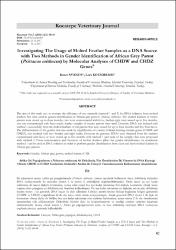| dc.contributor.author | Avanus, Kozet | |
| dc.contributor.author | Koenhemsı, Lora | |
| dc.date.accessioned | 2019-01-30T06:54:53Z | |
| dc.date.available | 2019-01-30T06:54:53Z | |
| dc.date.issued | 2018 | |
| dc.identifier.uri | http://dergipark.gov.tr/download/article-file/422534 | |
| dc.identifier.uri | http://hdl.handle.net/11630/5284 | |
| dc.description.abstract | Bu çalışmanın amacı Afrika gri papağanlarında (Psittacus erithacus) cinsiyet tayininde kullanmak üzere dökülmüş tüylerden DNA izolasyonunda iki metodun (metot 1 ve metot 2) etkinliğinin değerlendirilmesidir. Oniki tanesi üç aya kadar saklanmış; iki tanesi dışkıyla kontamine, ayrıca sekiz tanesi beş aya kadar saklanmış; biri dışkıyla kontamine olmak üzere toplam yirmi papağana ait dökülmüş tüy örnekleri kullanılmıştır. Üç aya kadar saklanmış ve dışkıdan ari on adet dökülmüş tüyden metot 1 ile genomik DNA başarı ile elde edilmiştir. Cinsiyet ayırımı kromo helikaz-bağlanma bölgesi genlerinin (CHDW ve CHDZ) çoğaltılması ile iki dişi sekiz erkek olarak sonuçlanmıştır. Ancak genomik DNA metot 1 ile dışkı ile kontamine olmuş tüyler ile birlikte beş aya kadar saklanmış olan tüylerin hiçbirinden, ayrıca metot 2 ile tüy örneklerinin tamamından elde edilememiştir. Dökülmüş tüylerin dışkı ile kontaminasyonu ve tazeliği cinsiyet tayininin başarısını etkilemektedir. Sonuç olarak metot 1, Afrika gri papağanlarında temiz ve taze dökülmüş tüylerden DNA izolasyonu yapılarak cinsiyet tayininde kullanılabilir. | en_US |
| dc.description.abstract | The aim of this study was to evaluate the efficiency of two methods (method 1 and 2) for DNA isolation from molted
feathers that were used in gender identification of African grey parrots (Psittacus erithacus). The molted feathers of twelve
parrots were stored up to three months, two were contaminated with feces, further eight were stored up to five months;
one was contaminated with feces totally feather samples of twenty parrots were used. Genomic DNA was isolated with
method 1 successfully from the molted feathers of ten parrots that were stored for up to three months and free from feces.
The differentiation of the gender that was made by amplification of chromo helicase-binding domain genes (CHDW and
CHDZ), was resulted with two females and eight males. However no genomic DNAs were obtained from the feathers
contaminated with feces or were stored up to five months with method 1 and none of the samples that were processed
with method 2. Feces contamination and freshness of molted feathers affect the gender identification. In conclusion
method 1 can be used in DNA isolation in order to perform gender identification from clean and fresh molted feathers in
African grey parrots. | |
| dc.language.iso | eng | en_US |
| dc.identifier.doi | 10.5578/kvj.66145 | en_US |
| dc.rights | info:eu-repo/semantics/openAccess | en_US |
| dc.subject | Cinsiyet | en_US |
| dc.subject | Afrika Grisi | |
| dc.subject | Papağan | |
| dc.subject | Dökülmüş Tüy | |
| dc.subject | CHD | |
| dc.subject | Gender | |
| dc.subject | Molted Feather | |
| dc.subject | African Grey | |
| dc.subject | Parrot | |
| dc.title | Afrika gri papağanlarına (Psittacus erithacus) ait dökülmüş tüy örneklerinin iki yöntem ile DNA kaynağı olarak CHDW ve CHDZ genlerinin moleküler analizi ile cinsiyet tanımlamasında kullanımının araştırılması | en_US |
| dc.title.alternative | Investigating the usage of molted feather samples as a DNA source with two methods in gender ıdentification of african grey parrot (Psittacus erithacus) by molecular analyses of CHDW and CHDZ genes | en_US |
| dc.type | article | en_US |
| dc.relation.journal | Kocatepe Veteriner Dergisi | en_US |
| dc.department | İstanbul Üniversitesi, Veteriner Fakültesi | en_US |
| dc.department | İstanbul Üniversitesi, Veteriner Fakültesi | |
| dc.identifier.volume | 11 | en_US |
| dc.identifier.startpage | 40 | en_US |
| dc.identifier.endpage | 44 | en_US |
| dc.identifier.issue | 1 | en_US |
| dc.relation.publicationcategory | Makale - Ulusal Hakemli Dergi - Kurum Yayını | en_US |



















